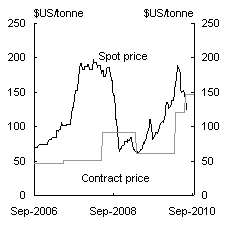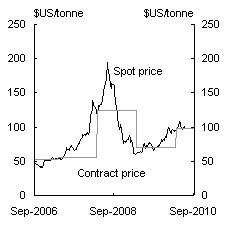The Australian economy is expected to grow by 3 per cent in 2010-11 and 3¾ per cent in 2011-12, returning to around full capacity over the next year. Fiscal and monetary stimulus is being withdrawn and there are early signs that private sector activity is picking up, although the transition to private sector led activity is proving to be a little slower than expected. Business investment — particularly mining investment — and exports are expected to strengthen over 2010-11 and 2011-12, driven by a substantial boost in the terms of trade and ongoing strong demand for Australian non-rural commodities.
The global economy is continuing to recover although the pace of growth remains uneven, with emerging economies, particularly in Asia, growing much more strongly than advanced economies. The world economy is expected to grow by 4½ per cent in 2010 and 4 per cent in 2011. There are substantial downside risks to the global outlook, including the European sovereign debt crisis, uncertainty over whether the US recovery will gain traction, the challenge in China of addressing overheating and the difficulty across the advanced economies in managing fiscal consolidation in a fragile global environment. The renewed global uncertainty is weighing on financial markets and business confidence.
Despite the heightened global uncertainty, robust growth in the Asian region is expected to continue to generate strong demand and high prices for non-rural commodities. The terms of trade are forecast to increase by 17 per cent in 2010-11, to around record levels, before declining in 2011-12. In line with this, nominal GDP is forecast to grow by 9¼ per cent in 2010-11 and 5¼ per cent in 2011-12, providing a substantial boost to incomes. There are substantial risks around the future profile of the terms of trade, with considerable short-term volatility in spot commodity prices and uncertainty about the timing, pace and extent of their decline as increased global supply capacity comes on line (Box 1).
Employment is expected to grow strongly, with the unemployment rate declining to 4¾ per cent in late 2011-12, around its full-employment level. Inflation is forecast to be 2¾ per cent through the year to the June quarter in both 2011 and 2012. Inflationary risks are on the upside, with the labour market reaching full capacity over the next year and the strong incomes boost from the terms of trade expected to see demand increasingly stretch the economy’s supply capacity.
Table 2 presents the major economic parameters used in preparing the Pre-Election Economic and Fiscal Outlook 2010 (PEFO). The PEFO and the Economic Statement are based on the same forecast assumptions and projection methodology.
Table 2: Major economic parameters(a) (b)

(a) Real and nominal GDP are year-average growth. Employment and the Consumer Price Index are through-the-year growth to the June quarter. The unemployment rate is the rate in the June quarter.
(b) The parameters for 2010-11 and 2011-12 are forecasts and those for 2012-13 and 2013-14 are projections.
Source: ABS cat. nos. 5206.0, 6202.0, 6401.0 and 6345.0, Treasury.
Box 1: The terms of trade
As in the Economic Statement, the terms of trade are forecast to rise by 17 per cent in 2010-11, underpinned by substantial increases in the contract prices of Australia’s commodity exports, including iron ore and coal. The terms of trade are forecast to fall by 4½ per cent in 2011-12, a little more than at Budget, as increased global supply capacity starts to weigh on prices of some commodities.
The 17 per cent rise in the terms of trade for 2010-11 is an upward revision from the 14¼ per cent rise forecast at Budget.
The Budget estimates for the terms of trade discounted the sharp and unsustainable run-up in spot prices of some commodities, particularly iron ore. A sharp fall in the iron ore spot price was anticipated and factored into the forecasts.
The Budget forecasts assumed that contract prices for bulk commodities would increase substantially — as they have done — but that the increases for iron ore prices would be substantially less than suggested by the prevailing spot prices.
Historically there have been wide divergences between spot prices of bulk commodities at any point in time and contract prices that are subsequently negotiated. These divergences will narrow under the new contracting arrangements for iron ore and metallurgical coal, but they can still be substantial (Chart A).
The Budget estimates were conservative, reflecting the volatility in prices and uncertainty about where they may settle. Subsequent information from industry sources suggested that the estimates for iron ore prices were too low, movements in spot prices notwithstanding, and the current forecasts have been revised accordingly.
The current forecasts are broadly consistent with current spot prices for the bulk commodities, although iron ore spot prices are lower than expected. However, market analysts suggest that part of the reason for this is the seasonal pattern of Chinese demand, which is expected to rebound later in the year when Chinese steel mills look to rebuild iron ore stocks.
Chart A: Iron ore (fines) spot and contract price

Note: The September quarter 2010 contract price estimate is based on estimates by market analysts. The iron ore spot price includes freight but the contract price does not.
Source: Bloomberg and ABARE.
Attempts by Indian authorities to limit the sale of iron ore to foreign markets may also provide support for iron ore prices.
Thermal coal and metallurgical coal contract price forecasts are consistent with current spot prices (Chart B).
Chart B: Thermal coal spot and contract price

Source: Global Coal and ABARE.
The medium-term outlook for the terms of trade, and for the commodity prices which underpin them, is uncertain. Empirical evidence produced by the International Monetary Fund suggests that commodity price shocks are typically persistent and that there are often no well-defined, time-invariant averages to which commodity prices return.
There is broad agreement that current high levels of prices are unsustainable and that a supply response will see commodity prices decline to more normal levels over the medium term, but the timing and extent of the expected decline is uncertain.